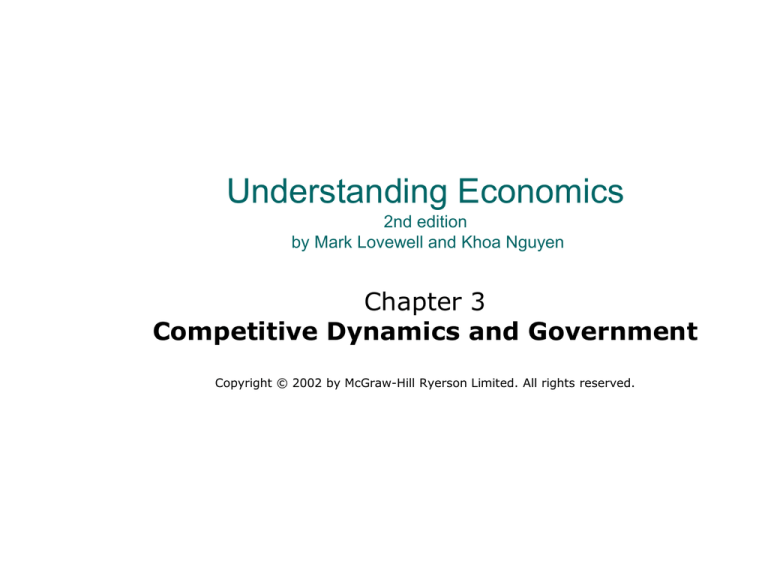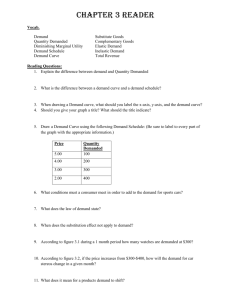
Understanding Economics
2nd edition
by Mark Lovewell and Khoa Nguyen
Chapter 3
Competitive Dynamics and Government
Copyright © 2002 by McGraw-Hill Ryerson Limited. All rights reserved.
Elastic and Inelastic Demand (a)
Price elasticity of demand shows how
responsive consumers are to price
changes
= % change in quantity demanded
% change in price
Copyright © 2002 by McGraw-Hill Ryerson Limited. All rights reserved.
• elastic demand means % change in
quantity demanded is more than %
change in price; in other words a small
change in price can cause a great change
in quantity demanded
Example
If I increase the price of product A, the
quantity demanded is going to go
down significantly
OR
If I decrease the price of product A,
the quantity demanded is going to up
significantly
Can you think of possible situations
where either scenario would occur?
Elastic and Inelastic Demand (a)
inelastic demand means % change in
quantity demanded is less than %
change in price. In other words, a
change in price will only affect the
quantity by a small degree.
Copyright © 2002 by McGraw-Hill Ryerson Limited. All rights reserved.
Example
The increase or decrease of the price
for a product is not going to affect the
quantity demanded by very much
Can you think of possible situations
where this scenario would occur?
Elastic and Inelastic Demand (a)
unit-elastic demand means % change
in quantity demand equals % change in
price. A change in price will affect the
quantity demanded by the same
degree
Copyright © 2002 by McGraw-Hill Ryerson Limited. All rights reserved.
Elastic and Inelastic Demand
Example:
During the winter, the vendor raises her price
by 20%, from $2->$2.40, causing a 50%
decrease in quantity demanded (from 1000
cones to 500 cones) ELASTIC
During the summer, the vendor raises her
price by 20%, from $2->$2.40, causing a
10% decrease in quantity demanded (from
1000 cones to 900 cones) INELASTIC
Calculating Price Elasticity of
Demand
A numerical value for price elasticity of
demand (ed) is found by taking the
ratio of the changes in quantity
demanded and in price, each divided
by its average value.
In mathematical terms:
ed = ΔQd ÷ average Qd
Δprice ÷ average price
Copyright © 2002 by McGraw-Hill Ryerson Limited. All rights reserved.
Elasticity > 1 = Elastic
Elasticity < 1 = Inelastic
Elasticity = 1 = Unit elastic
Determinants of the Price Elasticity
of Demand
There are four determinants:
necessities versus luxuries (more inelastic
for necessities and more elastic for
luxuries)
Availability of substitutes (products with
more substitutes more elastic)
portion of consumer incomes (products
with smaller portions more inelastic)
time (more elastic with the passage of
time)
Copyright © 2002 by McGraw-Hill Ryerson Limited. All rights reserved.
Elastic and Inelastic Demand (b)
Figure 3.1 Page 56
Inelastic Demand Curve
for Ice cream Cones
2.40
2.40
20%
2.00
D1
1.60
50%
1.20
0.80
0.40
0
500
Quantity Demanded
(cones)
1000
Price ($ per cone)
Price ($ per cone)
Elastic Demand Curve
for Ice Cream Cones
20%
2.00
D2
1.60
10%
1.20
0.80
0.40
0
500
1000
Quantity Demanded
(cones)
Copyright © 2002 by McGraw-Hill Ryerson Limited. All rights reserved.









